How the brain's little blue dot regulates your sleep
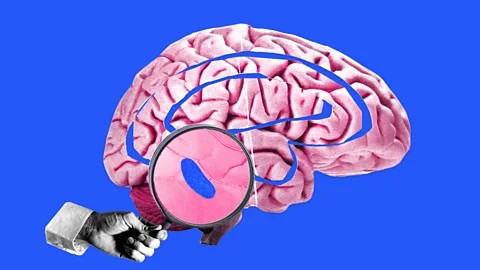 Serenity Strull/BBC/Getty Images
Serenity Strull/BBC/Getty ImagesThe locus coeruleus is emerging as a major new area of research interest, with many important functions such as regulating our attention and sleep.
Anyone with insomnia knows the impatience and frustration that accompanies sleeplessness, as you struggle to turn out the lights in your head and mute its inner voice. You long for a button or dial that could instantly dampen all that mental activity.
The idea of a mental dimmer switch is not quite as far-fetched as it might seem. Most neuroscientists now agree that our wakefulness exists on a kind of continuum. It is coordinated by a complex network of brain regions, at the heart of which lies a tiny bundle of neurons known as the "locus coeruleus", Latin for "blue dot".
It is a literal description: the neurons in the locus coeruleus are dyed the colour of sapphire from the production of a particular neurotransmitter, called norepinephrine. This is also a clue to the blue dot's function, since norepinephrine controls our physiological and psychological arousal.
For a long time, scientists assumed that the locus coeruleus was dormant during sleep, but it is now becoming clear that it is never completely quiet, with low levels of intermittent activity that may regulate the depths of our slumbers. A better understanding of this process may help to treat the disturbed sleep associated with conditions like anxiety.
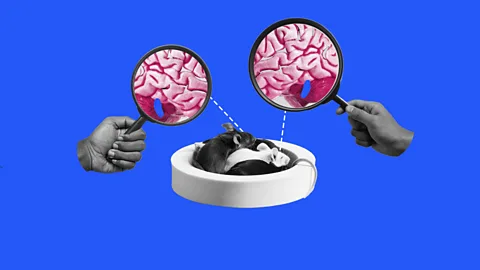 Serenity Strull/ BBC/ Getty Images
Serenity Strull/ BBC/ Getty ImagesThe brain's gear system
The locus coeruleus lies in the brain stem, just above the back of the neck – and contains around 50,000 cells, a tiny portion of the 86 billion neurons in the average central nervous system. Marie Antoinette's physician Félix Vicq d'Azyr was the first to note its existence in the late 18th Century – but for a long time, it failed to attract any further attention.
That began to change in the 20th Century, when it became clear that the locus coeruleus' blue pigment played a key role in brain signalling. Norepinephrine (also known as noradrenaline) raises the chance that a neuron will "spike" with an electric current. When they become active, cells in the locus coeruleus pass bundles of this neurotransmitter along their projections to other regions of the brain – enhancing the communication between the neurons in that area.
There are nuances to this process. Depending on the types of receptors they have, some neurons are more sensitive to smaller amounts of norepinephrine, while others only respond to higher thresholds. This means that, as the locus coeruleus activity rises, it will start to affect some brain areas more than others, which can have dramatic effects on things like our focus, concentration and creativity.
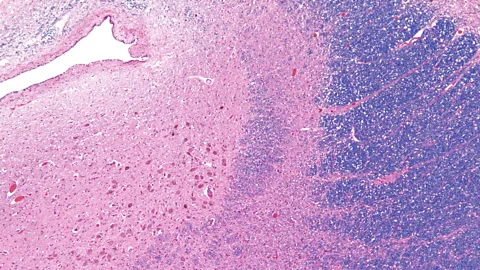 Wikimedia Commons/ Nephron
Wikimedia Commons/ NephronIn her book Hyperefficient: Optimize Your Brain to Transform the Way You Work, the neuroscience researcher and writer Mithu Storoni describes the locus coeruleus, and its control over norepinephrine signalling, as the brain's gearbox, with different modes that are best suited to certain kinds of activities.
Gear 1: very gentle activity in the blue dot. The low levels of norepinephrine mean that our attention is diffuse and our mind wanders from thought to thought.
Gear 2: moderate firing in the blue dot, accompanied by occasional spikes in response to the most relevant stimuli. The prefrontal cortex, which is involved in self-control and abstract thinking, is most sensitive to this concentration of norepinephrine. We may find it easier to stay focused on intellectual tasks in this brain state.
Gear 3: constantly high firing in the blue dot, which releases high levels of norepinephrine. This begins to trigger activity in brain regions associated with the "fight or flight response", while the prefrontal cortex starts to shut down. Thanks to the increased communication between neurons, you are extremely sensitive to your environment, but it can be hard to separate signal from noise. It becomes harder to focus, and you may begin to feel overwhelmed.
Many different factors determine which gear we are in, including the time of day, since the blue dot's activity shifts with our circadian rhythm. It tends to be low when we first wake up, rises during the day and falls in the evening.
Nocturnal vigilance
Given the blue dot's role in arousal, it makes sense that it would be quietest at night during sleep. It is not entirely silent, however, but fires sporadically – and recent research by Anita Lüthi at the University of Lausanne in Switzerland suggests that this activity may determine the quality of our slumbers.
Across the night, we alternate between different sleep stages. There is "rapid eye movement" (REM) sleep, which – as the name suggests – is marked by the flickering of our eyeballs. It is associated with vivid dreaming and is thought to be crucial for processing and consolidating memories. Much of our rest, however, is spent in non-REM (NREM) sleep, during which the brain may engage in a deep clean, clearing away cellular waste that may lead to neuronal dysfunction if it is allowed to accumulate.
Measuring brain activity in dozing mice, Lüthi found that NREM sleep was associated with temporary bursts of locus coeruleus activity every 50 seconds. This seemed to galvanise the thalami, a pair of egg-shaped regions which lie in the middle of the brain and are involved in sensory processing. As a result, the animal was more sensitive to outside stimuli, like noises – without fully waking. "It's generating this state of enhanced vigilance," Lüthi says. "It really gives you this idea that wakefulness can be graded in the brain."
Lüthi suggests that these regular periods of increased vigilance to potential threats would be essential for survival in the wild. "Sleep is so fundamentally important, but it has to supplement itself with a mechanism that allows for a certain degree of wakefulness," she says. "You need to remain reactive to the environment."
The onset of REM sleep was almost always associated with low locus coeruleus activity, suggesting that it also plays a central role in transitioning to this dream-filled state of being. "That transition to REM sleep has to be very well controlled," says Lüthi, "because in REM sleep, we have atonia". That's the temporary paralysis of our body, which prevents us from physically acting out our dreams. "We are completely disconnected from the environment."
Lüthi emphasises that her experiments were conducted in rodents, so we still need to confirm that the blue dot plays a similar role in human sleep. If so, she suspects that altered locus coeruleus activity could be implicated in conditions such as anxiety that may contribute to disordered sleep. She found that exposing her laboratory mice to mild sources of stress – such as knocking on their cage – raised the blue dot's activity and increased their vigilance throughout the night, resulting in fragmented sleep.
Finding mental calm
A burgeoning understanding of this neural pathway is leading some scientists to investigate whether different kinds of brain stimulation can calm the blue dot to improve sleep. A team in South Korea, for instance, have recently tested a headset that runs a small electrical current over one of the nerves in the forehead that is connected to the blue dot to temporarily damp down its activity – though it is not yet whether this reduces insomnia.
For now, we can try to think a bit more carefully about our behaviour in the evening, and avoid over-stimulation just before we go to sleep. "If you force yourself to keep going when you are tired, your brain copes by cranking its gear up to provide maximum horsepower for its struggling machinery – so much so that it almost 'gets stuck' at a high setting," writes Storoni in Hyperefficient. Simply letting our minds relax before bedtime – without TV, phones, or tablets – has long been considered good "sleep hygiene".
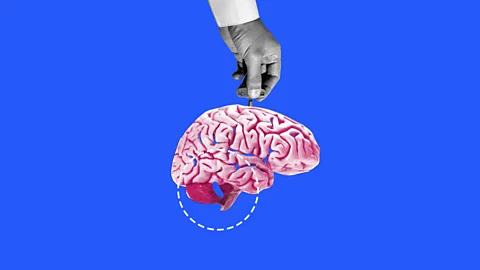 Serenity Strull/ BBC/ Getty Images
Serenity Strull/ BBC/ Getty ImagesWe may also take advantage of the two-way traffic between the locus coeruleus and the body. The blue dot is part of the autonomic nervous system, which controls unconscious physiological functions such as breathing, heart rate, and blood pressure. This is divided into two arms: the sympathetic nervous system, responsible for triggering a stress response, and the parasympathetic nervous system, which sets the body for rest and relaxation. And it seems that we can selectively activate each arm with different physical activities.
Moderate to intense exercise – walking, running, rowing, cycling, or boxing – is likely to kick the sympathetic arm into action, accelerating the blue dot's activity and increasing our mental arousal. That's great news if you're feeling groggy in the morning and need to wake up, but less useful when you're trying to calm your mind after a hard day's toil. You may think that physical exertion will tire you out, but if you're already having trouble sleeping, late-night gym visits are a bad idea.
Gentle stretching, on the other hand, can promote a relaxation response in the parasympathetic nervous system that simultaneously calms our thoughts and feelings. Controlled breathing exercises, such as pranayama – an ancient breathing technique that stems from yogic practices – appear to do the same job, with slower respiratory rhythms reducing overall arousal.
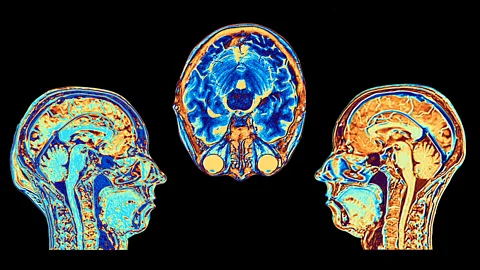 Getty Images
Getty ImagesWe can use this to our advantage as we wind down at night. Various trials suggest that meditation and mindful movements can reduce the time it takes to get to sleep, and improve our overall sleep quality, over and above the standard treatments for insomnia.
We do not quite have a physical switch that can turn down our mental activity at will. By managing our daily routine, however, and harnessing the mind-body connection, we will have a much better chance of getting the deep rest that we need.
* David Robson is an award-winning science writer and author. His latest book is The Laws of Connection: 13 Social Strategies That Will Transform Your Life. He is @davidarobson on Instagram and Threads and writes the 60-Second Psychology newsletter on Substack.
--
For trusted insights into better health and wellbeing rooted in science, sign up to the Health Fix newsletter, while The Essential List delivers a handpicked selection of features and insights.
